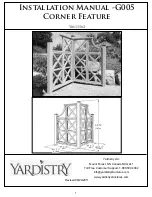
1015100100L02 1910V003
13
Assembly
8.4 Condensate
When air from the surrounding atmosphere is
compressed, different amounts of condensate
will accumulate in the pressure vessel depend-
ing on the humidity and temperature of the air.
This condensate is collected via the integrated
condensate separator, which is located between
the pressure vessel and the compressed air
connection. As soon as a certain fill level is
reached in the condensate separator, the con-
densate is drained off to the outside via the con-
densate drain.
i
Place a collector tray under the condensate
drain.
14
14 Condensate drain
8.5 Electrical installation
i
Connect the power cord to the mains socket
on the rear of the unit
i
Connect the power cord to a properly installed
mains socket with PE conductor.
i
Route the power cord in such a way that it is
not under any mechanical tension.
i
Before commissioning, verify that the power
supply voltage complies with the voltage
specifications of the type plate.
8 Commissioning
8.1 Remove the packaging
The unit is securely protected with packaging
material to ensure safe transportation.
i
Remove the packaging material.
i
Remove the protective film.
i
Check the unit for damage in transit.
i
Only lift the unit using the transport handles
and/or from the bottom.
8.2 Quick-release coupling – oper-
ating panel
The compressed air connection to the
pressure reducer has a constant pressure
of 1 bar (set at the factory).
The pressure can be adjusted at the
pressure reducer in the unit – see "9.5
Setting the pressure reducer".
i
Compressed air is extracted at the quick-re-
lease coupling (7.2 mm) via a hose adapter
piece on the operating panel of the unit.
i
Secure the pressure hose to the hose adapter
piece using a hose clip.
i
Connect the hose adapter piece to the
quick-release coupling.
8.3 Establishing the compressed
air connection
The unit has a 7.2 mm quick-release coupling
on its outer side. The matching hose nozzle for
a connecting hose with an internal diameter of
6 mm is included in the scope of delivery.
CAUTION
Damage to the quick-release cou-
pling if the cover of the unit is open
The quick-release coupling can be dam-
aged due to high compressive forces
during connection of the pressure hose.
i
The cover of the unit must be closed
and locked.
EN










































